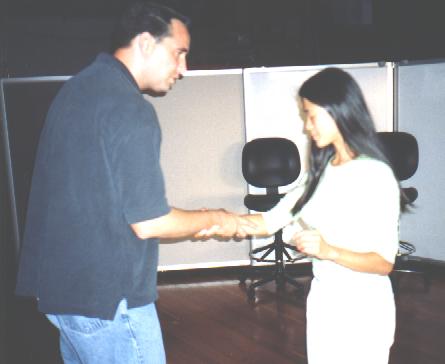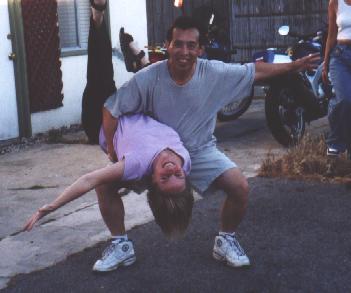






Show Cherry Drop:
Like the cherry drop, only more so.
Lift the flier up enough to support herself on the lifter's back
with her right leg.
To the lifter it feels more like lifting the flier up and over,
rather than just up.
It's important for the flier to flex abs and keep the right thigh
tucked in tightly.
Cherry Drop
(Larry: I don’t know why but I’m uncomfortable with the phrase rock, step, spin, down, lift, pose. It really is technically a rock step, triple step/spin, prep, lift, pose. It’s a question of semantics I suppose. I will say as a follow, I especially don’t like the word grab.)
(Spotter will be in front of leader, ready to catch head and shoulders of follower if necessary)
rock step, triple step/spin, prep, lift.
Hand hold - right to right, holding each other’s wrists
Both do a rock step
Triple step/spin - Lead will triple
step in place. The triple step for the follower is a spin/turn so
that she faces the leader with her hand behind her back. During the
turn, the followers wrist will rotate in leaders hand, she release
her grip for a moment to do this then reconnect. She will stay close
to the leader, taking care not to clock the base with her right elbow
as she turns. Her left hand will be on his shoulder.
Prep - follow doesn't put all of her
weight on leader (I don’t put any weight –though I do
maintain connection- on the leader at this point) Leader may want to
put left hand on follower's left waist.
Lift - As the flyer moves upward, lead places follower so that follower’s lower back on leaders thigh. Follow will have right knee bent and supported against the lead’s back. Follower’s left leg will be fully extended. Follower should be able to support herself in this position without the use her or the leader’s left hand.
Style - For the best visual effect, follower puts her hand over her head rather than toward the side at the end of this move. She makes a continuous straight line starting from her foot and ending with her hand. Leader can put his left hand in the air. Both look out toward the audience. This is traditionally used at the end of a piece.